1. Team Rendezvous in Tirana, Capital City of Albania
After a week of climbing on the Dalmatian Coast, Steffen Heimann and his Leipzig ‘No Limit Climbing Gym’ Opel van has arrived first in Tirana, the capital of Albania. Steffen, manager of the Gym and Volleyball club, is accompanied by team member Axel Hake (an architect who builds climbing walls for German public schools) and expedition organizers Gerald Krug and Christiane Hupe (from the Halle-based mountain books publisher Geoquest Verlag). There they met with Albanian team member, Gerhard Duro, from the Partisan Tirana section of the Albanian Alpinist Federation, as well as Ismail Beka and Tine Schrammel from the Albanian office of the German ‘Society for Technical Cooperation’ (Gesellschaft fuer technische Zusammenarbeit or GTZ). On the next day, they picked up the American team member from Washington DC, John Ely – that’s me – in Skenderbeg Square.
==
![Skenderbeg Square, Downtown Tirana]()
Downtown Tirana: A statue of Skenderbeg, the 14th century war leader in the Albanian struggles against the Turks and hence national hero, graces the main square of the capital city, together with a socialist-realist ‘people’s center and theatre’ from the Hoxha era, representative 18th century mosque and orthodox church, and neo-classical 1930s era government buildings built under Italian fascist influence in the 1930s.
==
It is my second timct), Orthodox and Catholic Christianity – it now has representative government, a relatively liberal and functional state, and an economy growing at between six and eight percent a year. Interestingly, however, despite vast and rapid economic and political development, mountaineering and rock climbing has lagged. Spurred on by prominent East Germans in the 1950s, a slew of routes were done, and a net of clubs and alpine camps continued this tradition, though no guidebooks and relatively few new ascents were achieved. Techniques likewise lagged a great deal.
e in Albania, and my first in ten years, and the changes leave one astonished. For decades, Albania was the most or second most isolated Stalinist state in the world, notorious for its tens of thousands of military bunkers built for defense against an Albanian ‘Prague Spring’ and costing the equivalent of housing every family in a new dwelling. But unlike North Korea, Albania transformed quickly as part the overall collapse of the Eastern Bloc in 1989-1990. After a few false starts, and the confusion of the Balkan Wars, the country is now a veritable success story. A state of mixed religious identities – Islamic, Bektashi (a local Gnostic sort of Islamic sect.
==
![Onuzi and Duro - Classical Style]()
Partisan Sport Group – Alpine Section in action: Kujitim Onuzi, now a geology professor, and Hassan Duro practicing artificial climbing techniques during the early sixties in the old socialist era. Hassan’s son Gerhard helps operate a mountain tourism business and joined us on the Arapit project.
==
The most mountainous country in Europe, Albania also has masses and masses of unclimbed mountains, walls, spires, crags and boulders. Indeed, while perhaps the most challenging country in continental Europe to access, it is hardly ultima thule. Remarkable hence is how little climbing activity it has seen. I have some knowledge here; I spent two years in Albania between 1999 and 2001 working for humanitarian organizations like CARE International and the International Rescue Committee, and got to know nearly all the people in the country with climbing ropes – about six or so.
Since then, little has happened. Italian soldiers from the Kosovo-Force Nato unit or the Albanian commandos set up a couple of sport routes and some rappelling anchors at the reservoir gorge near Tirana, and the old alpine section of Partisan Sport group has acquired some harnesses and top ropes and a small artificial climbing wall in their Tirana gymnasium. I have tended over the years to follow developments a bit, so I can add to an impromptu pdf called ‘Rock Climbing and Mountaineering in Albania: Photo Essay and Guide’ which was pasted together during my time as an NGO worker, and which my buddy John Middendorf kindly posted on his ‘Big Walls’ page after I returned from Albania. As the years have gone by, I’ve added gradually to its present version as a page at Summitpost, and thus keeping up with developments.
As part of this usually unremarkable search for news while surfing the web while adding materials, I ran across a report of a group of Germans sponsored by the GTZ put together some sport routes in nearby Montenegro, and I wrote to the main email address, a fellow named Ralf Gentsch, for information. Ralf has also been in the Theth Valley of Albania, the one valley in the whole country I hadn’t seen as the road had been out, scoping out climbing possibilities for a GTZ report. He sends back this fantastic picture of an unclimbed limestone one thousand meter big wall on Mt. Arapit, with the news that his friends, Gerald and Chris, two climbing guide publishers from Saxony in former East Germany, are planning a trip.
![Mt. Arapit South Face (2217M)]() The Ralf Gentsch photo which inspired the trip.
The Ralf Gentsch photo which inspired the trip.
In one of the few insane moments of my life, I write Gerald a blind email: 'I’m an aging "Ami" with no big wall experience since 1981, and mediocre free climbing skills. Still, can I come along?’ Astoundingly, Gerald responds. ‘How nice.’ Especially since they’re planning a trip first to the US.
So a few months later, we meet – in the Camp IV camp ground waiting line and long before the birds start chirping. After they get a place, they illustrate in a few days their for-real-ness. In search of shade in the August heat, we head for Middle Cathedral. I point out the ‘Bircheff-Williams’ and they go waltzing up, followed on the next day by ‘Outer Limits’ and ‘Cookie Monster’. A ‘day off’ bouldering in Camp IV ('Cobra', 'Bacher-Cracker', etc.), and then ‘Rostrum‘ falls. The next day Gerald and his friend return to camp in the early evening after a red point day on ‘Astroman,’ their fourth day in the Valley. The day after, we celebrate. My wife Bethany has called while I lay in the tent. She’s pregnant! This postpones our planned trip to Albania to late Summer, and despite my 50 years and new born daughter Thalia, I find myself one year later still in the in the mix, waiting for them in down town Tirana, duffles full – an A5 ledge, old grey jumars, chains of aging original Chouinard ovals, and healthy doses of belly-jelly and temerity.
Our main goal is the Gentsch picture: the South Face of Mt. Arapit in the Albanian portion of the ‘Accursed Mountains’, the Bjeshket e Namuna in Albanian and Prokletje in Serbo-Croat. Arapit’s main face is one of the largest limestone rocks in the world, and certainly the largest unclimbed one in continental Europe – a real plum. Of course no one in the party has actually ever seen it up close. I have some experience in Albania leading terrified NGO workers up steep but easy limestone crags which seemed accessible on Saturday afternoons from the roadside, the sum total of our 5th class experience in the country. I had posted Gentsch’s picture on a Super Topo thread: Snide responses assure me it must be crumbly like feta cheese – once they figure out that ‘Albania’ is not ‘Alabama.’ Still, confident of the team’s skill set, I repress my fears and remember all the cool limestone I climbed there a decade ago.
2. The Trip North to Theth – the Chamonix of Albania
After going shopping – pushing three carts in a row through the huge new Euro style grocery store – the team meets with Geology Prof. Kujtim Onuzi, one of the early members of the Partisan section, and Tapir Alia, one of the two Albanians who first climbed the Arapit Face via the ‘Master’s Route’ in 1987.
==
Axel Hake (left) and Gerald Krug (right) look on as Tapir Alia (center right) shows them his original topo book of their ascent on Arapit, with Prof. Kujitim Onuzi (center left) translating into German.
==
This route starts in the middle of the main face, but then cuts left up the broken buttresses and finishes on the vegetated slabs – avoiding the vertical ‘big wall’ section rising up to the West Peak. Thus the main face on the longest axis leading to the East Peak, is yet unclimbed.
==
Steffen illustrates important quantities of gummi-bears included.
![Shopping in Tirana]()
No Limit Climbing Gym mini van parked in front of one of Tirana’s huge new suburban shopping centers to be loaded with supplies.
==
![Mountain Road to Thethi]()
The tenuous mountain roads leading out of the dry coastal regions into the very temperate valley of Theth. The manifold outcrops, crags, faces and entire mountains of climbable limestone in the region are evident in the picture.
==
The next morning, the collected expedition left for the glacial valley of Theth, the ‘Chamonix’ of Albania – but since the road over the pass into Theth is rather notorious, we are happily supported by a four-wheel drive vehicle and driver from the GTZ.
Theth, a beautiful deep glacial valley 800 meters above sea level, has about 30 families living in it, a famous ‘Kulla’ (or blood-feud protection tower), a Catholic church, a 9-year school, and a little museum.
![Kulla in Theth]() The Kulla in Theth
The Kulla in ThethThe Shala River flows through it in steep drops, due south until it reaches the Koman reservoir system. The main access road comes in over the Thore Pass (1775m) from Boge on wretched gravel roads, and even this approach is blocked by snow throughout the winter. From the pass, the view is spectacular: the limestone ramparts, slabs and towers of Mt. Stegut (2075m), Mt. Radohimes (2568m), and Mt. Riskalit (2324m) rise west of the valley beyond the Thore pass. On the eastern side, the staggering limestone ridges and faces of Mt. Boshtit (2222m) spring up to the south guarding the Valbona Pass (1800m) into the nearby and spectacular Valbona Valley, with Mt. Valbona (1966m), Mt. Alijes (2471m), M. Popluqes (2569m) and Mt. Kolajet (2418m) running from south to north, and Mt. Jezerca, at 2692m, the highest peak in the Accursed Mountains, climbing in limestone steps and buttresses due east behind Popluqes and Kolajet.
![Mt. Lagojvet and Neighboring Towers]() Maja Lagojvet and neighboring towers.
Maja Lagojvet and neighboring towers.
At the northern dead end to the valley, broken only on the left by the steep meandering path of the Peja Pass, is the mist-shrouded form of Mt. Arapit. Behind it to the north, reaching into Montenegro, are the striking fifth class towers of the Maja Lagojvet group, offering dozens of potential class III, IV, and V routes up the soaring faces and ridges of its eastern flanks.
Nearly all of the families in Theth have worked together with the GTZ to set up a ‘Han’ system, using the Turkish word for ‘inn’, providing room and board for visitors in nearly all of the local dwellings, for ca. 15-20 Euro a night including three meals.
![Ms. D. Deda]() Ms. Deda Manages the Okel Guest House.
Ms. Deda Manages the Okel Guest House.Theth is broken up into several settlement groupings up and down the Valley, and we stayed with a family in Okel, the northern and highest of the groupings. Dark in the main room in the evenings due to the weak local electricity, the fire roared, and we were served a wholesome dinner of pickled vegetables, fresh butter, new bread, goat’s cheese, salad, Turkish coffee and lots of the local grape brandy, known as Rakija or ‘Raki’, and in this case, tasting nearly as good as a fancy Italian grappa.
The next morning we drove further up the valley, and after a tow of the Opel van by the GTZ’s Daimler 4x4, we set up camp in a beautiful meadow by the last major spring before the trail goes up right to the Peja Pass, or left to the base of Mt. Arapit’s gaping, curved, vertical-overhanging south face of tiered limestone.
3. Mount Arapit – Approach and Formulation of Ascent Strategy
Mt. Arapit, at 2217m, is lower than the surrounding peaks. Nonetheless it totally dominates the valley of Theth, towering over its northern entrance next to the Peja Pass. Arapit means the ‘Dark One’, the ‘Black One’, the ‘Moor’ or ‘Arab’, called so because of the forbidden character of its shaded grey vertical limestone. Though frequently called the ‘Matterhorn’ of Albania because of its sharply pointed peak and its position at the top of Albania’s most famous Alpine valley, it south face rises nearly 1000 vertical meters above the famous cave entrance at its base, rising in layers of differing patterns of limestone. As my teammates noted, it resembles Yosemite’s Half Dome in that it has one huge vertical face, while being rounded on the other three sides, and since it is by far the largest wall in the Dinaric Alps, and one of the largest limestone faces anywhere it the world, being the same height as the famous Marmolata in the Italian Dolomites, it is astounding that it has seen such little climbing activity. More striking, the quality of the limestone for climbing is at least as good, if not better, than the Dolomites, and frequently formed into fantastic, steep and featured karst formations that make for wonderful climbing – once some of the few of the teetering ‘microwaves’ and other ‘kitchen appliances’ have been toppled off their precarious settings.
When we arrived, outside of a fantastic picture by German climber Ralf Gentsch, who has been working for the past few years for the GTZ in Montenegro, Albania and Kosovo, we had virtually no previous knowledge of the face beyond some hard to interpret penciled topos and descriptions from Onuzi and friends in Tirana, and were happily surprised to find the quality of rock in the area as good as it was. Though we brought a portaledge and lots of aid gear, the plan was to do a free route up the steepest unclimbed portion of the south face to the top of the East Peak. Though the West Peak is higher, the steep scree and talus field rises sharply from the base of the East Peak to the West, shortening the climbing potential by several hundred meters to the true summit, though the rock there is just as steep and rises is some fantastic and exciting looking cracks and buttresses.
Six people can carry a lot, and so on the first day, we started schlepping up the climbing gear up the steep one hour approach from our base came to the foot of the wall. Just as we arrived there, near the famous cave entrance, we were shocked to find a huge troop, some 15-30 people, camped in the terraces left of the scree field – Bulgarians!
==
A view of the Arapit south face from near the base. A couple of the Bulgarian cavers, who are camped in the hillside grove to the left, can be seen in descent.
==
At first we were really afraid that some other folks had gotten their first to ‘our’ wall, but were gradually pacified when we learned that they were cavers, exploring the inside of Arapit, and not intending to climb the outside. Nonetheless, or indeed, precisely for that reason, these folks are some serious dudes. Arapit is most famous for its cave: one of the top ten in the world, it has the record for the highest vertical rise of any cave in the world; and the Bulgarian Speleological Group – including biologists, geologists, speleological experts and newcomers - has been exploring it now for four years. This year they have gotten up to 318 meters above the cave entrance, exploring a whole new towering funnel reaching up into the innards of what is really a giant piece of Swiss cheese. There are also holes they have explored in the top of the mountain; in theory the whole thing can be connected, but they still have hundreds of meters upward or downward to go…
But we are relieved that they are not climbers in the usual sense; and the next day, our first attempt at climbing went well. Gerald and Axel managed to climb the first seven pitches, using new ultra-light Bosch drills to put in 3/8 in double bolt belay anchors, and to protect some of the harder moves, while Chris and Gerhard followed and managed to fix the first three pitches.
The only wrinkle was that our planned tactic of one leading and one support team appeared somewhat dangerous; though the rock quality overall was really quite good, lots of loose material which needed to be cleaned up came ripping down on the second team, not to mention the distressed Bulgarian cavers below.
==
![Approach to Raki on Arapi]()
==
![Raki on Arapi s First Pitch]() Tine Schammel following the first pitch, which meanders easily up through a series of roofs.
Tine Schammel following the first pitch, which meanders easily up through a series of roofs.
==
![Parallel Bands in the Lower Slabby Portion]()
Gerald leading the third pitch, illustrating the slabby character of the lower part of the wall.
==
So the next day, Steffen and myself went up alone and fixed the next four pitches to the first band. It would have of course been possible to climb Arapit without fixed lines, but since we planned to bolt all the anchors and the most difficult passages so that the following parties could avoid hammer and pitons completely, using only cams and nuts, it made sense to fix the lower half of the route and avoid sleeping on the wall. So the A5 Ledge became base camp head rest, and more important, all the delightful wall munchie food we had purchased was freed for base camp consumption.
![View Up from 3rd Pitch]() Gerald belaying from the top of the 3rd pitch. The slabby portion of the face goes up for four more rope-lengths to the first tier of overhangs visible above Gerald. The tree marks the half-way station, with the route going up and right through overhanging rock (crux pitches) to the ‘u’-shaped slot, from which three lower angle pitches lead to the summit.
Gerald belaying from the top of the 3rd pitch. The slabby portion of the face goes up for four more rope-lengths to the first tier of overhangs visible above Gerald. The tree marks the half-way station, with the route going up and right through overhanging rock (crux pitches) to the ‘u’-shaped slot, from which three lower angle pitches lead to the summit.4. Forays on the Crags Above the Peja Pass and the Balkan Peace Park Initiative
Fortunately, the fact that the Theth Valley and especially the vast assortment of crags, spires and towers in basins above the Peja pass leading north to Montenegro are almost completely unclimbed left lots of space for those not immediately occupied with the Arapit project.
Gerhard, Axel and John made the first foray, following some of Steffen suggestions as he had been up earlier to see about the possibility of a ledge system escape east off the main face of Arapit.
The 2200 meter eastern flank of Qatat e Verlla, known as Maja Shale or ‘Saddle Mountain’ forms a beautiful, karst-formed 270 meter cliff, the most easily assessable of the numerous formations from the Peja pass – albeit two and a half hours steep approach up the pass and mountainsides above from our base camp. The three, with Axel in the lead, put in a six pitch route, with one 5.10b passage, called ‘Pacifist Pirates’, afterwards leaving all the gear there.
==
![Shepard on Saddle Mountain]()
We met a shepard and his sheep on the steep meadows below Saddle Mountain, who was proud of his flock and welcome to share this mountainside with his foreign visitors.
==
Saddle Mountain’s West Face viewed from the summit of Arapit, with Maja Malisores, Qatet e Verlla, and Jerzerca’s Northe-East Spur visible behind. The first two routes the group did go up past the two trees on the cliff bare visible in as blotches in the lower left of the formation, with the 3rd, 'Watchtower', ascending the independent tower further left. The climbable length of the whole is 5-7 pitches for perspective!
==
The next day Steffen and John went back up and climbed the obvious crack just to the right, calling it the ‘Crack of the Peaceful Smuggler’, three pitches with two of 5.9; and on a windy day afterwards, Axel, John and Steffen did a beautiful route on the nearby tower, ‘All Along the Watchtower,’ with one 5.10a move and lots of steep moderate climbing on the fantastically carved karst formations, much steeper and more difficult then they looked from the ground, but of surprisingly good quality.
==
![All Along the Watchtower]() Axel Hake leading the first pitch of All Along the Watchtower (5.10a, 3 pitches).
Axel Hake leading the first pitch of All Along the Watchtower (5.10a, 3 pitches).Saddle Mountain with the the routes Pacifist Pirates (7 pitches, 5.10b) and Crack of the Peaceful Smuggler (3 pitches, 5.9) inked in. 'All Along the Watchtower' climbs the separated formation just left in the rocks out of the picture on the left from the two bushie areas.
Gerhard Duro following, having to wait for a photo op at the wide and tiring crux of Pacifist Pirates.
Steffen Heimann leading the crux on the first ascent of Peaceful Smuggler, complete with his heavy Hilti.
==
![Saddle Mountain - All Along the Watchtower]()
Steffen Heimann on a first attempt at 'All Along the Watchtower.' The route goes up through some crux slabs at 5.10 pg13, and then meanders right to the notch in the upper right to a belay. Afterwards it leads for two more fine pitches up and around some very steep cracks and mantles to the top of a separate tower of the Saddle Mountain formation, making an excellent outing. Axel Hake later completed the route belayed by John Ely.
==
Meanwhile, John, as a supporter of the ‘Balkan Peace Park’ idea developed by a small British non-governmental organization founded by two ‘peace studies’ researchers in Bradford, UK, Antonia and Nigel Young, put together a petition. This gave the ones relegated to base camp watch something else to do, as there are already many visitors on the trails up into the high mountains which went right by our base camp. The petition read: ‘We are alpinists, cavers, hikers and friends, or inhabitants in the Shala River Valley, and we support the idea of establishing a multinational peace park combining the beautiful mountains of Albania, Montenegro and Kosovo.’ We collected five pages of signatures, comprising some 150 signatures from all over, especially East European countries, and more than 95 percent of all the people who passed by or visited base camp signed the petition, while taking the occasion to gaze into the telescope at the climbers busy at work on the Arapit project. In the meantime, the peace park idea, which following the first examples combining parks in Norway and Sweden (Morokulian), and the US and Canada (Glacier/Waterton), has now some two dozen examples around the world. The Balkan Peace Park project runs summer camps now every summer in Theth, teaching English, and is starting similar camps this year in Kosovo and next in Montenegro. And the GTZ has also begun supporting the idea, developing its multinational cross-border tourism projects in the same region which includes the peace park, essentially the entirety of the ‘Accursed Mountains’ or Southern Dinaric range including northern Montenegro, south-western Kosovo and the main valleys of Northern Albania down to the Koman reservoir system, a beautiful but ambitious project recognizing the mountain and adventure tourism will become a crucial part of the economy in this region.
![Peace Park Banner]() John and Gerhard hold up the Balkan Peace Park banner for a publicity photo. The sketch of the peaceful climbing bear courtesy Axel Hake, who is a trained architect.
John and Gerhard hold up the Balkan Peace Park banner for a publicity photo. The sketch of the peaceful climbing bear courtesy Axel Hake, who is a trained architect.
On the second day of pushing the route up, Chris and Gerald got to the first difficult passage, a crackly slab leading delicately up to an awkward 5.11 overhanging passage which Gerald drilled on lead, followed by a strenuous and overhanging layback corner protected by cams. It is one of the most exciting pitches due to the steepness, and the fact that the rock around the crack pulls off like old scabs with the slightest outward torque, encouraging one to appply pressure only in one strenuous direction. This is followed by a 5.10a pitch which leads up to a big horizontal slot about four feet high and quite deep at the half way point. This would make a possible bivy spot in a bad rainstorm, as most of the rest of the rock would be washed with water. (Climbing this section with Daniel later made me realize why his comrade Ferdl had laughed one dark retreating night at my selection of old chrome-moly lost arrows and angles. While the limestone is relatively good in quality, it really needs soft steel pitons which glue into the grooves, not the hard steel which breaks it apart; and anything smaller than a one inch cam, including most stoppers, are only rarely placed well enough to catch the sort of fall this route's runouts would generate. Drilling three of four good bolts per pitch, and double-bolted belay anchors is the wise and safe policy for establishing a route which will hopefully see visitors, local and foreign, in the years ahead.) The next part, an anxiety producing passage through the wall where it goes suddenly steep and blank, proved easy. An elegant corner, hard to see from the ground, was steep but moderate, and leads to some fantastic climbing on exuded iron crimpers on the vertical face of limestone. What looked to be vertical blank limestone with a severe case of flakey dandruff turned out to be an extremely hard version of the kind of exuded chicken pox stuff found in West Virginia’s New River Gorge. This was no problem for Gerald - except that when he reached the belay, after drilling the holes, he noted an absence of bolts, and was thus forced to lower on a tied-off drill bit.
5. Arrival of the Bavarian Rope-Rockets and the BRF Film Team
Meanwhile, back at base camp, two strong climbing members of the team, Ferdinand ‘Ferdl’ Triller and Daniel Wilhelm from Augsburg arrived together with the Leipzig mountain film director Hugo Scholz and his camera and sound men, Sepp and Hannes from Allgau.
![Filming the first ascent of Raki on Arapi]() Jumaring into place to film attempts at the crux 13th pitch (5.11d) about 2/3s up the face.
Jumaring into place to film attempts at the crux 13th pitch (5.11d) about 2/3s up the face.
The film trio were there to produce a show on the climb and the Albanian Alps for the Bavarian TV series Bergauf, Bergab (‘Up Mountain, Down Mountain’). Besides the allure of becoming TV stars in Bavaria, the film team livens up the party. Hugo in particular is what the Germans call a ‘Typ’, a character. In his sly intellectual style, he manages to draw any sort of person into his narrative net, with a disorganization that drives his camera and sound crew mad, but which seduces anyone he cozies up to. We were treated to long interviews in the base camp of a Bulgarian cave biologist, young, female and fetching, as she displays the various species, some probably new, that she and her comrades have discovered.
![Speleological Wildlife]() Hugo Scholz, Dresdener Filmmaker, interviews a Bulgarian Biologist on new beetles species found in the Arapit cave for his TV film.
Hugo Scholz, Dresdener Filmmaker, interviews a Bulgarian Biologist on new beetles species found in the Arapit cave for his TV film.Then there was the long conversation with the goat herd while Gerhard fell asleep amidst the goats, or the syringe action Hugo produced as a means of injecting an entire bottle of bourbon into a watermelon. Added to this were the interesting and less than flattering stories he had to tell about the German special forces during the Iraq War, the corruption of the recently retired President of Germany, or the seediness of Reinhard Messner. Hugo reminds one that behind the prestigious tradition of German film directorship is the original medicine-show and cabaret huckster.
The next day, Ferdl and Gerald jumared the fixed lines, followed by the camera team, who were also six foot plus trained Bavarian mountain guides with legs like kangaroos and thus used to this sort of thing.
![Hugo and Sepp in Camp]() Hugo amuses himself and some others injecting a watermelon with Albanian bourbon, while his more focused Sound-man, who is also a licenced Bavarian mountain guide, watches progress on Arapi.
Hugo amuses himself and some others injecting a watermelon with Albanian bourbon, while his more focused Sound-man, who is also a licenced Bavarian mountain guide, watches progress on Arapi.Despite being slowed by the need for getting good camera shots, the two pushed the route up to pitch 14, getting lost a bit in the blankness after Ferdl’s Yosemite-style pendulum into nowhere from a corner which had ended nowhere. As the day began to end, the two looked about, backtracked, and discovered a free possibility by going in the other direction: the crux 5.11d rounded undercling leading to a no hands shoulder jam rest before another 5.11 bridge, smear and layback multi-maneuver for several exciting moves. This followed a nearly as hard steep layback pitch whose crux involved reaching dynamically for a pine tree root before scrabbling like a hobbit escaping wolves into the tree itself for a dangling belay stance with a view straight down into the abyss between the climbers dangling legs and the scurrying Bulgarian speleologists below: the anchor is the two bolts, but the seat is a branch which positively sways out over the overhang just beneath it. Pushing through the crux pitches was made especially interesting due to a dropped monkey wrench, which meant that the protection bolts could be hammered in, but not screwed shut until the next day, despite the overhanging rock and accompanying increase in the anxiety levels.
Hugo's film for Bavarian television is available for watching on You Tube in three parts, albeit in German and without subtitles.
![Roofed Band 1]() Three Views illustrate the Scale of Arapit's South Face. Zoom photo of Chris and Daniel in the roofed band - This telephoto shot shows two climber near the tree smack in the middle of the south face of Arapi.
Three Views illustrate the Scale of Arapit's South Face. Zoom photo of Chris and Daniel in the roofed band - This telephoto shot shows two climber near the tree smack in the middle of the south face of Arapi.![Roofed Band 2]() In this shot of the same area from a wider perspective, the climbers are still barely visible. The 'band' above them is not crumbly rock, but formed by the presence of exuded iron holds on the relatively solid limestone sheets.
In this shot of the same area from a wider perspective, the climbers are still barely visible. The 'band' above them is not crumbly rock, but formed by the presence of exuded iron holds on the relatively solid limestone sheets.![Roofed Band 3]() In this view, the place of the tree in the middle of the central band of the Arapi south face is evident, but the climbers are now no longer visible.
In this view, the place of the tree in the middle of the central band of the Arapi south face is evident, but the climbers are now no longer visible.
6. Tourism Interlude in the Village and Valley of Thethi
The rest of us, tired either from working on Arapit or schlepping up to Saddle Mountain, take the day off to visit Theth village. First, we visited the ‘Dukagini Museum.’
![Thehi Dukagini Museum and Mt. Boshtit]()
This is named after one of the main groups of clans or ‘banners’ that had inhabited this high mountain valley from at least the late medieval period, and it is housed in a quaint old 18th century building rising on a bunch of overhanging rocks. A local farmer’s son was the curator. In his ‘Siemann’s Mobile’ football strip and sweat pants, he showed us around, proudly letting me take a picture of him with his trophy, a fox skin.
==
![Boy and Foxskin]()
Temporary Keeper of the Keys and Tourguide of the Dukagini Museum with museum display object caught and skinned by himself.
==
Then we went for a view inside the famous ‘Kulla’ nearby. A kulla is a traditional tower refuge for potential victims of blood-feuds, and Thethi’s is likely the best known example in the country. Afterwards, a walk uphill fifteen minutes south-east along the gorge escarpments leads to a bath in the fantastic 120 meter natural water fall (right out of Caspar David-Friedrich).
The caretaker, right, standing next to images of his forebearers, speaks with Gerhard, left, in the upper floor of the Kulla, with examples of traditional old Albanian furniture and fur carpets on display.
Finally, we visit the red Theth school house. There, the Balkan Peace Park Project (‘B3P’ for ‘Balkan Three Country Park’), which had been running a four week summer camp teaching English to the local children in the red school building, had organized a end-of-camp celebration.
![Thehi School Chorus]() School Chorus at the concluding Celebration of the Balkan Peace Park Summer School.
School Chorus at the concluding Celebration of the Balkan Peace Park Summer School.This proved a perfect occasion to unload the materials which Steffen, a gruff old East-German type Leipziger on the outside, but with a heart of gold on the inside, had organized from his various contractors and clients from the big climbing gym he manages in Saxony. Footballs, games, educational materials, coloring pencils, and stacks of t-shirts were given to the ‘B3P’ folks, who happily distributed them after the ceremonies.
==
![Peace Park School Celebration]()
A music teacher from Manchester and his son help orchestrate the final celebratory performance of the Balkan Peace Park summer school program at Thethi's 9-Year school. Note the bright school is painted red with frescos of whales, micky mouse, and peace doves on it, and a solar collector.
==
![Inside Thethi s School]()
Two members of the Arapi expedition share the contributions which Steffen Heimann has organized for the school kids of Thethi with the organizers of the Balkan Peace Park summer school.
==
7. Push to the Top; First Red Point; First Red Point by a Single Leader
On the final day of climbing, Axel and Gerald finished up the route, followed by the redoubtable Bavarian team of Ferdl and Daniel. With Gerald leading and Axel belaying this went fast. Some fantastic steep bridging in chimney and off width above the crux led to vegetated slabs which were deceptively difficult.
![First Ascent Team]() Axel and Gerald celebrate the first ascent of Raki on Arapi.
Axel and Gerald celebrate the first ascent of Raki on Arapi.Indeed, despite the hard and steep rock, this was one of the issues caused by a south face in such a low altitude and southern Mediterranean climate – lots of plants everywhere. Here Gerald was forced to rest on a couple of protection points while engaging in some impromptu gardening and calisthenics, including: a wild hand traverse followed by a no holds mantle into a grass patch with body scum in full deployment, and then, yarding on some overhanging heather for several moves until one was able to grab the branches in both hands and make a vegetable pendulum left onto an exciting 5.8 no hands friction stance.
![Raki on Arapi - Gebonkt]() Hannes and Sepp film the final handshake.
Hannes and Sepp film the final handshake.(Those who followed the route continued to be amazed by Gerald’s skills on lead; while not perhaps having the sheer monkey competence of the Bavarian competition sport duo of Daniel and Ferdl, Gerald managed to scope out, lead, garden and secure the route with the kind of mental equilibrium which marks the really good climbers from the rest.) Daniel and Ferdl, however, followed right behind Gerald and Axel. Alternating leads, they red pointed the whole route that day from top to bottom. Both crews topped out around seven pm after 18 solid pitches. The only wrinkle was Axel, who on the very last pitch managed to pull off a ‘toaster’ and drop it on his foot, breaking his third toe and making the walk down somewhat miserable, albeit victorious.
==
![Ferdl and Daniel Have the first red point]()
Ferdl Triller and Daniel Wilhelm managed to red point the entire route on the second complete ascent, an hour and a half behind the first!
==
The next day Chris tried to red point the entire route on lead, belayed by Steffen, failing with one wild fall on the crux pitch, to the delight of the film crew, who had rappelled down from the top and filmed her pushing through the crux sections of the climb. The next day, Gerald and Gerhard cleaned off the fixed ropes from the first six pitches, while Daniel grabbed the first complete individual red point, cruising up the route in about eleven hours, belayed by a suitably impressed John. They both got back late, having to clean off the fixed ropes off pitches six through ten while being the first to test the entire rappel route on regular double ropes. This provided lots of excitement below, as the entire descent was watched through the telescope. Daniel, after leading the whole thing,shared a red bull with his partner and a shunt to protect the brake hand, and then popped off peacefully into the depths, finding one rappel anchor after another in the dark. John followed as the pack horse, the moths gathered around his headlamp, with a beefy 200 meter coiled strand of eleven mill static line swinging wildly from his rear harness loop, eventually joined by several 60 meter lengths of this and that draped on his shoulders. The slightest motion would send the system into a Foucaultian motion, tweeking him back and forth all the way down while, the flopping coils sweeping bits of rock small and large from the ledges and making a racket that could be heard as far as base camp.
After that, we organized a victory feast as there was lots celebrate. All of the group had managed the route, excepting our Albanian member Gerhard; but since Arapit was his first real foray into multi-pitch climbing, climbing a third of the thing was a big enough adventure for him. Hugo, after long and complex negotiations, bought a lamb from the Theth village folk, and shared it out with a newly arrived Hungarian caving team combined with lots of what Gerhard called ‘German oxygen’, viz., Beer. John supplied a large bottle of the best Raki supplied by his friends in Tirana from the old NGO days. In a long period of revelry, naming controversy finally led to an inebriatious voting system of blind ballots and ideas of mixed virtue. One such was ‘moon walk’ given the frequently late night rappel actions. Gerald suggested ‘coliseum’ because of the convex vertical layered character of the wall – sitting up there is like high seats behind the football goals. Daniel proposed ‘Trans Balkan Express’ in tune with the multinational character of the team and the idea of a multinational peace park. John’s idea, ‘Sea of Limestone’, also had some followers but was dreary. Finally, Steffen, quiet until that point, said simply: Why not ‘Raki on Arapi.’ That name won a landslide of votes, and despite the fact that no one had actually had a proper snort on the mountain itself...the whole trip was like a Dionysian play with a happy end.
![Raki on Arapi - Expedition Group Photo]() A group photo of the whole expedition including the film team after the climbing was finished.
A group photo of the whole expedition including the film team after the climbing was finished.
![Arapit Phototopo]() A photo topo of the August 2010 Geoquest route 'Raki on Arapi' (UIAA, VIII/5.11d, 18 pitches, pg). Photo - R. Gentsch, Graphics G. Krug
A photo topo of the August 2010 Geoquest route 'Raki on Arapi' (UIAA, VIII/5.11d, 18 pitches, pg). Photo - R. Gentsch, Graphics G. Krug
8. Raki on Arapi – Route Description and Epilogue
That was the result: the first ascent of the main south face of Arapit, 800 meters high with about 970 meters of climbing, 18 long pitches up to UIAA grade VIII (three pitches of medium or hard 5.11) with obligatory UIAA VII (moderate 5.10), with good protection throughout - albeit in ‘alpine’ terms. The route goes straight up the middle of the highest wall, and is easy to repeat since all the belays have two 3/8 in bolts and rappel rings, with the 5.11 passages also protected by bolts. A complete set of camalots, with doubles in the one and two inch size, and one three inch is sufficient; stoppers are not much use in the limestone. Above the sixth pitch, the route gets harder, but the rock remains good, with only a few broken sections; overall it is incredibly diverse, with delicate face moves, fantastic steep karst cracks with intensely good incut holds, the bizarre slab-vegetable pitch, some great hard laybacking – every pitch offers some new and different kind of limestone experience. But an attractive part of the route is that the first six pitches leading to the first band make a kind of ‘pleasure tour.’ Minus the tricky 130 meter 3rd class approach (don’t fall), it is all moderate 5.7 and below, with one bolt protected 5.10a move. It was there in the first band that a ‘Elbe Sandstone’ style summit register has been placed; and Gerhard has promised to return with his Albanian friends a put the obligatory bottle of Raki there as well.
[Beta Remarks: It probably makes sense to attempt the route in one very long day, though there is one good cave-like bivy spot possible in the incut shelf by the mid-point tree. Hauling bags due to the sharp limestone edges and overhangs would be a trial. A short fixed line for the beginning of the approch saves nerves, and care must be exercised on this portion with moderate climbers, as a slip on the tilted gravel slabs would be a final one. The penultimate rappel point anchor is one the drop line center of gravity and separate from the belay bolts to avoid a sharp edge, but otherwise a descent is possible by rappeling from the belay anchors without major problem; the tilted gravel approach slab can also be rappelled. The group used double 70m lines, so that would be the recommended arrangement for this route. If one choosed to descend by foot, the trail is marked but not obvious. The key point is to angle left/north at a couple of points; it might be wise of foot descent is planned to visit the rim beforehand. Though low in elevation, the area has an alpine micro-climate with frequent afternoon thundershowers, so rain gear and headlamps are mandatory, as are hard hats.]
This makes the first direct route up the main face of one of the largest limestone walls in the world, following the 1987 ascent of the ‘Master’s Route’ by two Albanians, Alir Tapia and Sokol Doko, of a route which went to the first band and then followed the broken buttresses to the left onto the 3rd class summit slab in the space between the West and East peaks. This leaves a huge space for more climbs here, not to mention the solid limestone rock which populates the entire region.
After finishing Arapit, it was time for the film team and the Bavarian team members to drive home to Germany, accompanied by a disappointed Axel, having confirmed in the town of Shkodra that his toe was indeed broken. The rest of the gang, however – Gerald, Chris, Gerhard and John – piled into Steffen’s ‘No Limit’ Opel and drove back to Tirana, where they happily crashed on Tine’s porch in the diplomatic quarter, and searched the crags around the capital for the best possible sport routes.
Eventually, after getting lost in the thorn bushes on Mt. Daiti, and being turned back in Kruje by the fact that a garbage dump was only a few hundred meters from the possible sport routes, the gang settled on the beautiful Bovilla gorge on the Zall-Herr road just north of Tirana. There we spent the rest of the week putting in sport routes in two areas, some twelve in all, between 5.6 and 5.12a. Despite the intense heat, this was possible because the gorge allows one to stay in the shade by picking the right crags, and offers a fantastic swimming hole for lunch break, including a diving platform into a deep karst pool, and a swimming escapade upstream through caverns of overhanging limestone, including an underwater dive into a water fall cavern formed by a crashing waterfall and the swirling darkened whirlpool the fall produces. At the end, we visited the Partisan Club in Tirana, where Gerhard’s father Hassan is coach of the climbing group, and saw their climbing wall. Unfortunately, its status is uncertain, as the entire sport facility has just been privatized, but there was a storage place anyway; and we used the occasion to unload a huge supply of gear, several ropes, lots of quickdraws, harnesses, belay devices, biners and a box of shoes from Steffen’s climbing gym, so that the Albanians, who don’t even have a gear store in the country yet, can begin to develop some of the fantastic climbing possibilities in their country, aptly known as Shqiperia in Albanian, that is, the ‘land of the Eagles.’
Thanks to Our Sponsors
The Arapit Climbing Expedition would like to thank our sponsors for their help in making the trip so successful. The GTZ provided us with transport help and logistics, The Leipzig Section of the German Alpine Association provided us with bolts and hardware, the Bosch Co. supplied us with two fantastic new light GBH-18V-LI drills, the Skylotec Co. provided us with harnesses, rope and apparel, and Deuter provided us with camelback and regular mountain packs. We want to especially thank the people of Albania, who where ever we met them were friendly and helpful.
![Skylotech Fly Swatter]() Gerhad Duro got laughs showing us is proposed new product for skylotec, one of our sponsors: the Thethi-Lite flyswatter! It has yet to be approved for mass production....
Gerhad Duro got laughs showing us is proposed new product for skylotec, one of our sponsors: the Thethi-Lite flyswatter! It has yet to be approved for mass production....




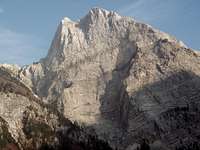









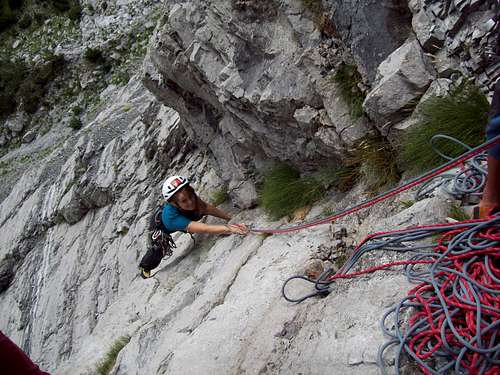
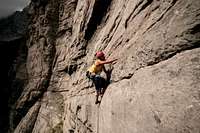
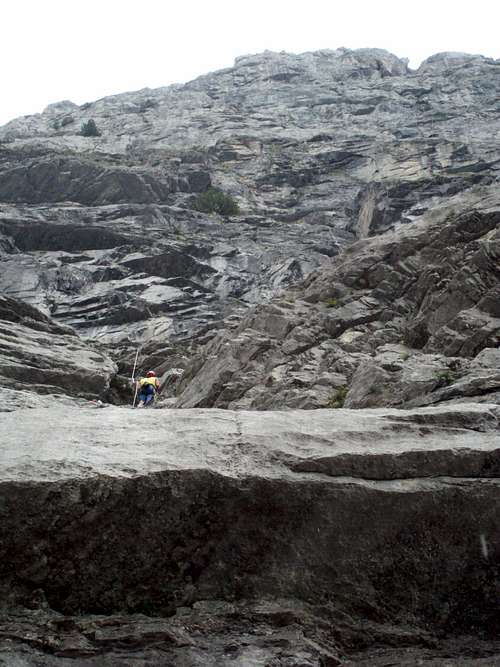

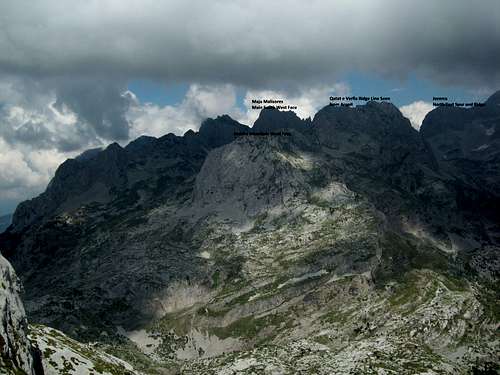
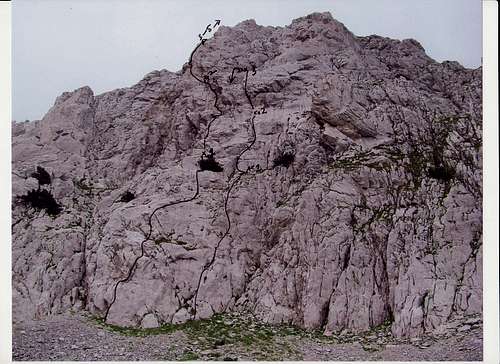


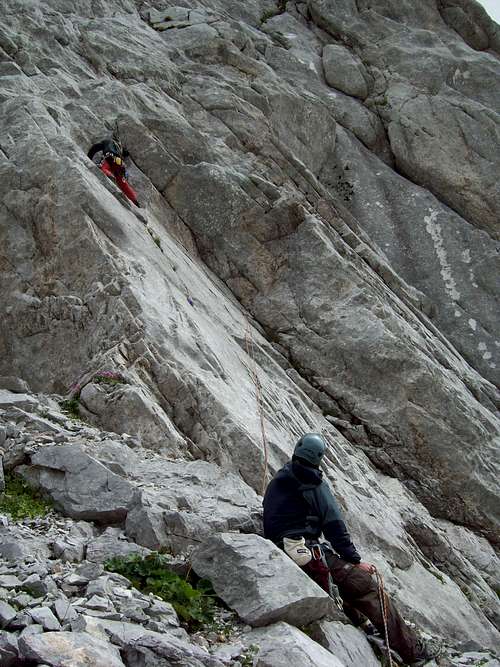



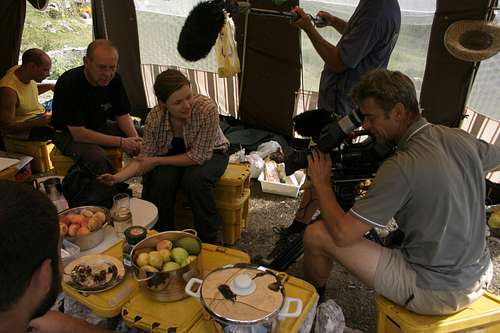
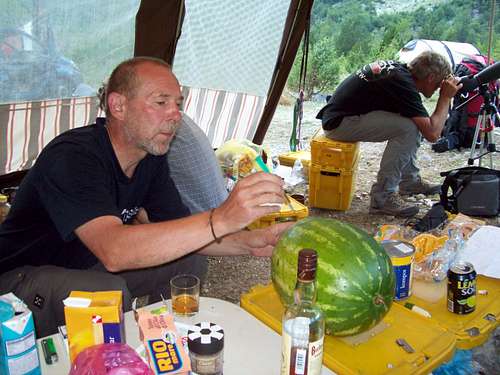

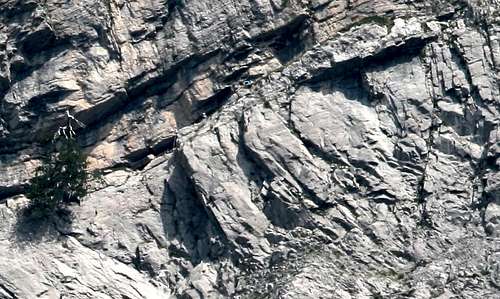










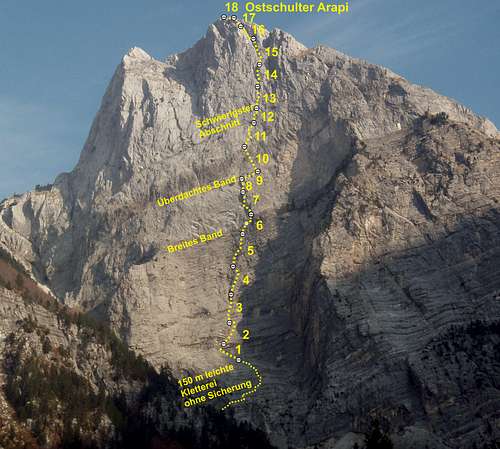
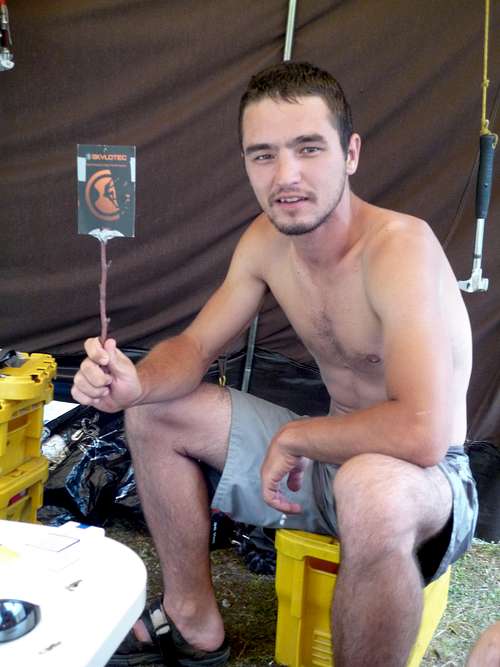




Comments
Post a Comment